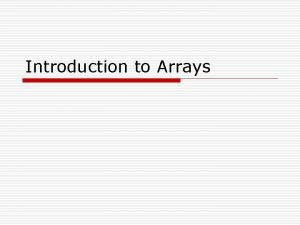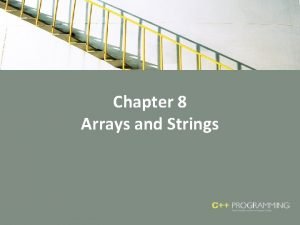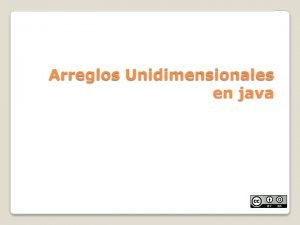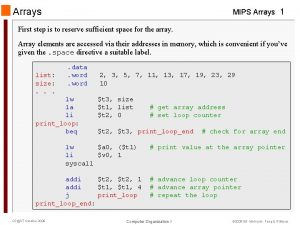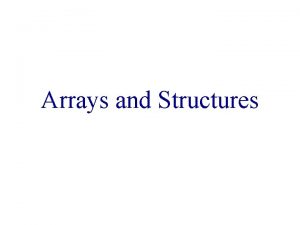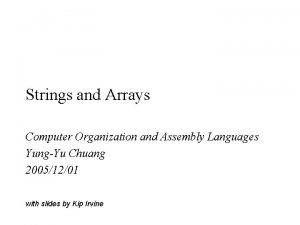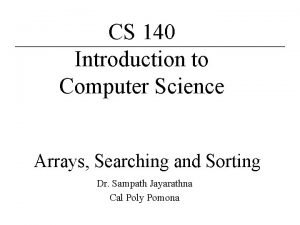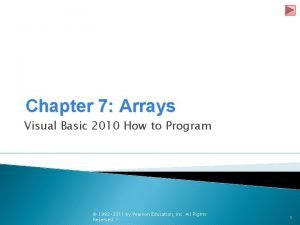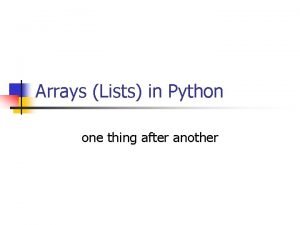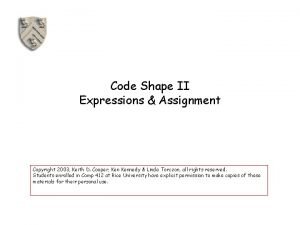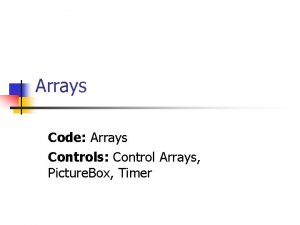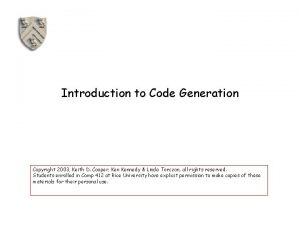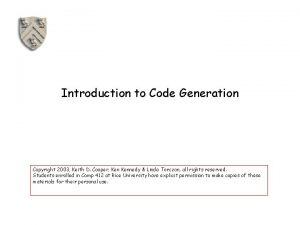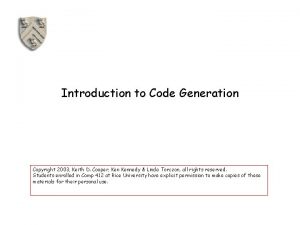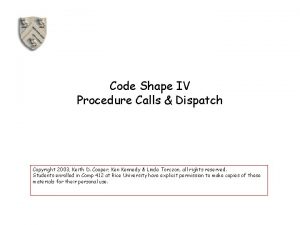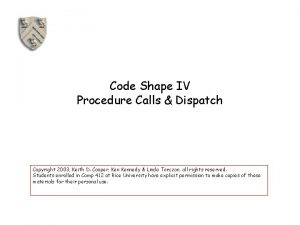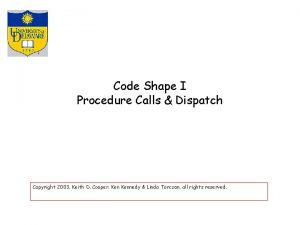Code Shape II Expressions Arrays Copyright 2003 Keith












![How does the compiler handle A[i, j] ? First, must agree on a storage How does the compiler handle A[i, j] ? First, must agree on a storage](https://slidetodoc.com/presentation_image_h2/393f124e5262f3178e06ce40850b2e14/image-13.jpg)


![Computing an Array Address A[ i ] • @A + ( i – low Computing an Array Address A[ i ] • @A + ( i – low](https://slidetodoc.com/presentation_image_h2/393f124e5262f3178e06ce40850b2e14/image-16.jpg)
![Computing an Array Address A[ i ] • @A + ( i – low Computing an Array Address A[ i ] • @A + ( i – low](https://slidetodoc.com/presentation_image_h2/393f124e5262f3178e06ce40850b2e14/image-17.jpg)
![Optimizing Address Calculation for A[i, j] In row-major order where w = sizeof(A[1, 1]) Optimizing Address Calculation for A[i, j] In row-major order where w = sizeof(A[1, 1])](https://slidetodoc.com/presentation_image_h2/393f124e5262f3178e06ce40850b2e14/image-18.jpg)

![Array References What about A[12] as an actual parameter? If corresponding parameter is a Array References What about A[12] as an actual parameter? If corresponding parameter is a](https://slidetodoc.com/presentation_image_h2/393f124e5262f3178e06ce40850b2e14/image-20.jpg)
![Example: Array Address Calculations in a Loop DO J = 1, N A[I, J] Example: Array Address Calculations in a Loop DO J = 1, N A[I, J]](https://slidetodoc.com/presentation_image_h2/393f124e5262f3178e06ce40850b2e14/image-21.jpg)
![Example: Array Address Calculations in a Loop DO J = 1, N A[I, J] Example: Array Address Calculations in a Loop DO J = 1, N A[I, J]](https://slidetodoc.com/presentation_image_h2/393f124e5262f3178e06ce40850b2e14/image-22.jpg)
- Slides: 22

Code Shape II Expressions & Arrays Copyright 2003, Keith D. Cooper, Kennedy & Linda Torczon, all rights reserved.

Code Shape x+y+z x + y t 1 x + z t 1 y + z t 1+ z t 2 t 1+ y t 2 t 1+ z t 2 x y z x z y x • What if x is 2 and z is 3? • What if y+z is evaluated earlier? y z y x z Addition is commutative & associative for integers The “best” shape for x+y+z depends on contextual knowledge There may be several conflicting options

Code Shape Another example -- the case statement • Implement it as cascaded if-then-else statements Cost depends on where your case actually occurs O(number of cases) • Implement it as a binary search Need a dense set of conditions to search Uniform (log n) cost • Implement it as a jump table Lookup address in a table & jump to it Uniform (constant) cost Compiler must choose best implementation strategy No amount of massaging or transforming will convert one into another

Generating Code for Expressions The key code quality issue is holding values in registers • When can a value be safely allocated to a register? When only 1 name can reference its value Pointers, parameters, aggregates & arrays all cause trouble • When should a value be allocated to a register? When it is both safe & profitable Encoding this knowledge into the IR • Use code shape to make it known to every later phase • Assign a virtual register to anything that can go into one • Load or store the others at each reference Relies on a strong register allocator

Generating Code for Expressions expr(node) { int result, t 1, t 2; switch (type(node)) { case , , , : t 1 expr(left child(node)); t 2 expr(right child(node)); result Next. Register(); emit (op(node), t 1, t 2, result); break; case IDENTIFIER: t 1 base(node); t 2 offset(node); result Next. Register(); emit (load. AO, t 1, t 2, result); break; case NUMBER: result Next. Register(); emit (load. I, val(node), none, result); break; } return result; } The concept • Use a simple treewalk evaluator • Bury complexity in routines it calls > base(), offset(), & val() • Implements expected behavior > Visits & evaluates children > Emits code for the op itself > Returns register with result • Works for simple expressions • Easily extended to other operators • Does not handle control flow

Generating Code for Expressions expr(node) { int result, t 1, t 2; switch (type(node)) { case , , , : t 1 expr(left child(node)); t 2 expr(right child(node)); result Next. Register(); emit (op(node), t 1, t 2, result); break; case IDENTIFIER: t 1 base(node); t 2 offset(node); result Next. Register(); emit (load. AO, t 1, t 2, result); break; case NUMBER: result Next. Register(); emit (load. I, val(node), none, result); break; } return result; } Example: x Produces: y

Generating Code for Expressions expr(node) { int result, t 1, t 2; switch (type(node)) { case , , , : t 1 expr(left child(node)); t 2 expr(right child(node)); result Next. Register(); emit (op(node), t 1, t 2, result); break; case IDENTIFIER: t 1 base(node); t 2 offset(node); result Next. Register(); emit (load. AO, t 1, t 2, result); break; case NUMBER: result Next. Register(); emit (load. I, val(node), none, result); break; } return result; } Example: x 2 Generates: y

Extending the Simple Treewalk Algorithm More complex cases for IDENTIFIER • What about values in registers? Modify the � IDENTIFIER case Already in a register return the register name Not in a register load it as before, but record the fact Choose names to avoid creating false dependences • What about parameter values? Many linkages pass the first several values in registers Call-by-value just a local variable with “funny” offset Call-by-reference needs an extra indirection • What about function calls in expressions? Generate the calling sequence & load the return value Severely limits compiler’s ability to reorder operations

Extending the Simple Treewalk Algorithm Adding other operators • Evaluate the operands, then perform the operation • Complex operations may turn into library calls • Handle assignment as an operator Mixed-type expressions • Insert conversions as needed from conversion table • Most languages have symmetric & rational conversion tables Typical Addition Table

Handling Assignment (just another operator) lhs rhs Strategy • Evaluate rhs to a value • Evaluate lhs to a location (an rvalue) (an lvalue) lvalue is a register move rhs lvalue is an address store rhs • If rvalue & lvalue have different types Evaluate rvalue to its “natural” type Convert that value to the type of *lvalue Unambiguous scalars go into registers Ambiguous scalars or aggregates go into memory Let hardware sort out the addresses !

Handling Assignment What if the compiler cannot determine the rhs’s type ? • This is a property of the language & the specific program • If type-safety is desired, compiler must insert a run-time check • Add a tag field to the data items to hold type information Code for assignment becomes more complex evaluate rhs if type(lhs) rhs. tag then convert rhs to type(lhs) or signal a run-time error lhs rhs This is much more complex than if it knew the types

Handling Assignment Compile-time type-checking • Goal is to eliminate both the check & the tag • Determine, at compile time, the type of each subexpression • Use compile-time types to determine if a run-time check is needed Optimization strategy • If compiler knows the type, move the check to compile-time • Unless tags are needed for garbage collection, eliminate them • If check is needed, try to overlap it with other computation Can design the language so all checks are static
![How does the compiler handle Ai j First must agree on a storage How does the compiler handle A[i, j] ? First, must agree on a storage](https://slidetodoc.com/presentation_image_h2/393f124e5262f3178e06ce40850b2e14/image-13.jpg)
How does the compiler handle A[i, j] ? First, must agree on a storage scheme Row-major order Lay out as a sequence of consecutive rows Rightmost subscript varies fastest A[1, 1], A[1, 2], A[1, 3], A[2, 1], A[2, 2], A[2, 3] (most languages) Column-major order (Fortran) Indirection vectors (Java) Lay out as a sequence of columns Leftmost subscript varies fastest A[1, 1], A[2, 1], A[1, 2], A[2, 2], A[1, 3], A[2, 3] Vector of pointers to … to values Takes much more space, trades indirection for arithmetic Not amenable to analysis

Laying Out Arrays The Concept A These have distinct & different cache behavior 1, 1 1, 2 1, 3 1, 4 2, 1 2, 2 2, 3 2, 4 1, 2 2, 2 1, 3 2, 3 1, 4 2, 4 Row-major order A 1, 1 1, 2 Column-major order A 1, 1 2, 1 Indirection vectors 1, 1 1, 2 1, 3 1, 4 2, 1 2, 2 2, 3 2, 4 A

Computing an Array Almost always a power of 2, known at compile-time Address use a shift for speed A[ i ] • @A + ( i – low ) x sizeof(A[1]) • In general: base(A) + ( i – low ) x sizeof(A[1])
![Computing an Array Address A i A i low Computing an Array Address A[ i ] • @A + ( i – low](https://slidetodoc.com/presentation_image_h2/393f124e5262f3178e06ce40850b2e14/image-16.jpg)
Computing an Array Address A[ i ] • @A + ( i – low ) x sizeof(A[1]) • In general: base(A) + ( i – low ) x sizeof(A[1]) int A[1: 10] low is 1 Make low 0 for faster access (saves a – ) Almost always a power of 2, known at compile-time use a shift for speed
![Computing an Array Address A i A i low Computing an Array Address A[ i ] • @A + ( i – low](https://slidetodoc.com/presentation_image_h2/393f124e5262f3178e06ce40850b2e14/image-17.jpg)
Computing an Array Address A[ i ] • @A + ( i – low ) x sizeof(A[1]) • In general: base(A) + ( i – low ) x sizeof(A[1]) What about A[i 1, i 2] ? This stuff looks expensive! Lots of implicit +, -, x ops Row-major order, two dimensions @A + (( i 1 – low 1 ) x (high 2 – low 2 + 1) + i 2 – low 2) x sizeof(A[1]) Column-major order, two dimensions @A + (( i 2 – low 2 ) x (high 1 – low 1 + 1) + i 1 – low 1) x sizeof(A[1]) Indirection vectors, two dimensions *(A[i 1])[i 2] — where A[i 1] is, itself, a 1 -d array reference
![Optimizing Address Calculation for Ai j In rowmajor order where w sizeofA1 1 Optimizing Address Calculation for A[i, j] In row-major order where w = sizeof(A[1, 1])](https://slidetodoc.com/presentation_image_h2/393f124e5262f3178e06ce40850b2e14/image-18.jpg)
Optimizing Address Calculation for A[i, j] In row-major order where w = sizeof(A[1, 1]) @A + (i–low 1)(high 2–low 2+1) x w + (j – low 2) x w Which can be factored into @A + i x (high 2–low 2+1) x w + j x w – (low 1 x (high 2–low 2+1) x w) + (low 2 x w) If lowi, highi, and w are known, the last term is a constant Define @A 0 as @A – (low 1 x (high 2–low 2+1) x w) + (low 2 x w) And len 2 as (high 2 -low 2+1) Then, the address expression becomes @A 0 + (i x len 2 + j ) x w Compile-time constants

Array References What about arrays as actual parameters? Whole arrays, as call-by-reference parameters • Need dimension information build a dope vector • Store the values in the calling sequence • Pass the address of the dope vector in the parameter slot • Generate complete address polynomial at each reference What about call-by-value? • Most c-b-v languages pass arrays by reference • This is a language design issue @A low 1 high 1 low 2 high 2
![Array References What about A12 as an actual parameter If corresponding parameter is a Array References What about A[12] as an actual parameter? If corresponding parameter is a](https://slidetodoc.com/presentation_image_h2/393f124e5262f3178e06ce40850b2e14/image-20.jpg)
Array References What about A[12] as an actual parameter? If corresponding parameter is a scalar, it’s easy • Pass the address or value, as needed • Must know about both formal & actual parameter • Language definition must force this interpretation What if corresponding parameter is an array? • Must know about both formal & actual parameter • Meaning must be well-defined and understood • Cross-procedural checking of conformability Again, we’re treading on language design issues
![Example Array Address Calculations in a Loop DO J 1 N AI J Example: Array Address Calculations in a Loop DO J = 1, N A[I, J]](https://slidetodoc.com/presentation_image_h2/393f124e5262f3178e06ce40850b2e14/image-21.jpg)
Example: Array Address Calculations in a Loop DO J = 1, N A[I, J] = A[I, J] + B[I, J] END DO • Naïve: Perform the address calculation twice DO J = 1, N R 1 = @A 0 + (J x len 1 + I ) x floatsize R 2 = @B 0 + (J x len 1 + I ) x floatsize MEM(R 1) = MEM(R 1) + MEM(R 2) END DO
![Example Array Address Calculations in a Loop DO J 1 N AI J Example: Array Address Calculations in a Loop DO J = 1, N A[I, J]](https://slidetodoc.com/presentation_image_h2/393f124e5262f3178e06ce40850b2e14/image-22.jpg)
Example: Array Address Calculations in a Loop DO J = 1, N A[I, J] = A[I, J] + B[I, J] END DO • Sophisticated: Move comon calculations out of loop R 1 = I x floatsize c = len 1 x floatsize ! Compile-time constant R 2 = @A 0 + R 1 R 3 = @B 0 + R 1 DO J = 1, N a=Jxc R 4 = R 2 + a R 5 = R 3 + a MEM(R 4) = MEM(R 4) + MEM(R 5) END DO
 Copyright 2003
Copyright 2003 Copyright 2003 pearson education inc
Copyright 2003 pearson education inc Copyright 2003
Copyright 2003 Copyright 2003
Copyright 2003 Code commit code build code deploy
Code commit code build code deploy Parallel arrays examples
Parallel arrays examples Array of arrays c++
Array of arrays c++ Ragged array
Ragged array Partially filled arrays
Partially filled arrays Parallel arrays
Parallel arrays Why do we need arrays?
Why do we need arrays? Dynamic arrays and amortized analysis
Dynamic arrays and amortized analysis Variables unidimensionales ejemplos
Variables unidimensionales ejemplos Arrays bidimensionales java
Arrays bidimensionales java Array mips
Array mips Polynomial representation using array in c
Polynomial representation using array in c Arrays in arm assembly
Arrays in arm assembly Global arrays in c
Global arrays in c Computer science arrays
Computer science arrays Searching and sorting arrays in c++
Searching and sorting arrays in c++ Arrays visual basic
Arrays visual basic Python find index of max
Python find index of max Disadvantages of array
Disadvantages of array







